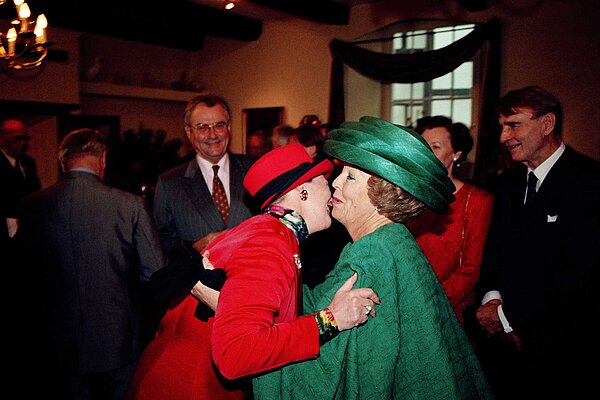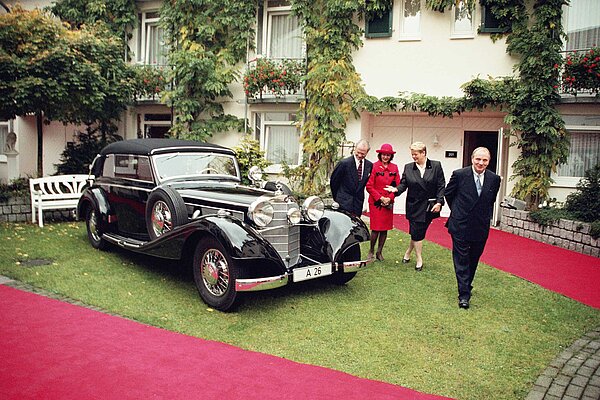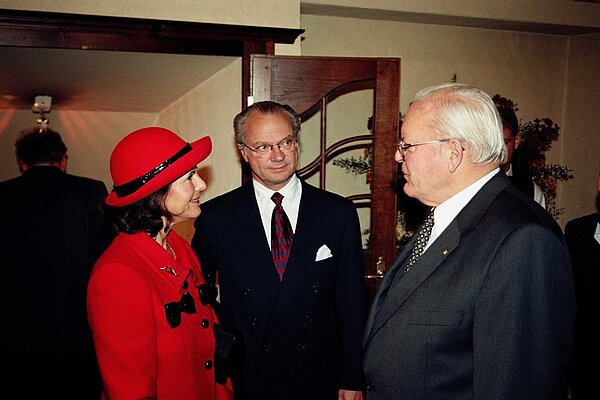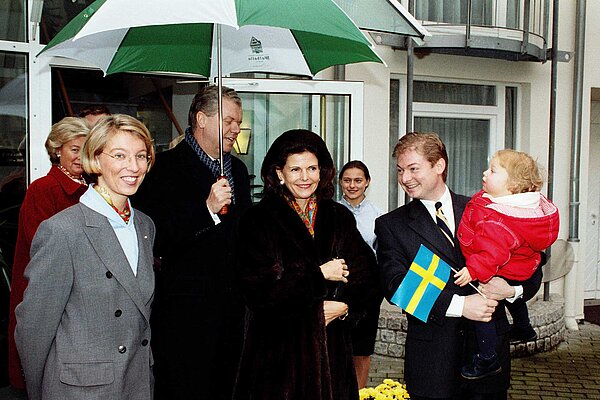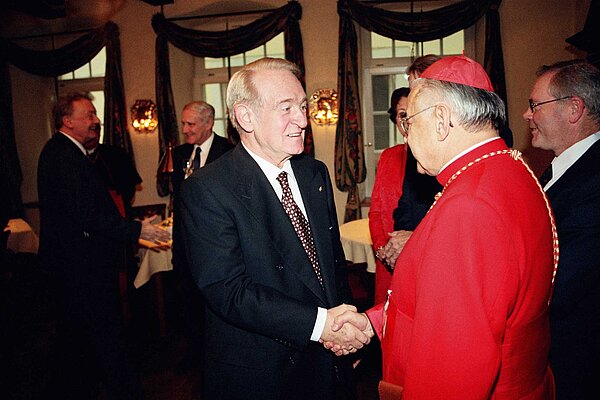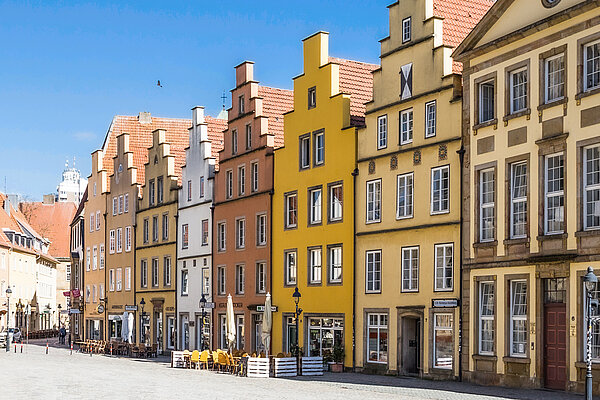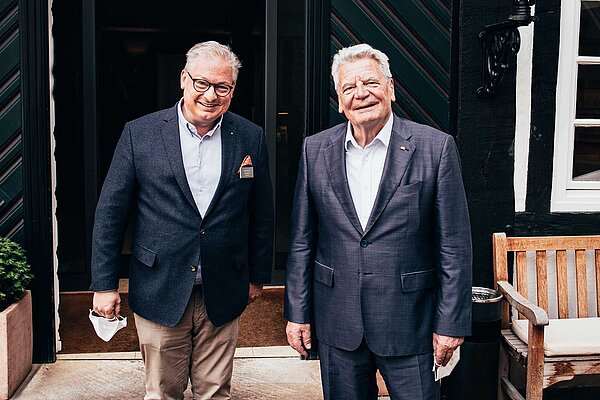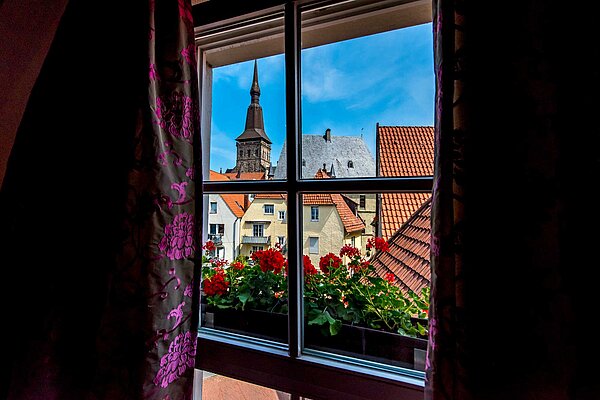Essay on Erich Maria Remarque's relation to the Romantik Hotel Walhalla (see news "Nothing new in the West wins Oskar...")
Erich Maria Remarque from Osnabrück published his novel in 1956: "The Black Obelisk", which is set in Osnabrück and, among other places, in the Hotel Val halla.
"The Black Obelisk" is an interwarnovel by Erich Maria Remarque. It is about the survivors of the First World War, who, in keeping with the subtitle History of a belated youth, are unable to build a "normal" life after their wartime experience. The background to the plot is the Great Depression and galloping inflation in Germany.
The Black Obelisk is thematically a loose sequel to Im Westen nichts Neues and Der Weg zurück. The novel was first published in 1956, but Remarque did preliminary work on the novel in the 1920s and 1930s, ...
The Black Obelisk also reflects the tricks people use to ensure their survival. For example, some women look for rich and successful men to marry. This leads to confusion and jealousy for Ludwig when he "loses" "his" Gerda to the hotel and restaurant owner Knobloch from the Hotel Walhalla. Ludwig and Georg Kroll take him out with food stamps, which they have bought in stock. Since the food stamps have hardly more value with the time, they drive him thus each time to the white rage.
The Black Obelisk is still read as a key Osnabrück novel. The poet innkeeper Eduard Knobloch, for example, was in reality called Eduard Petersilie and did not preside over the still existing Hotel Walhalla in Osnabrück....... " Source: Excerpts from Wikipedia
The Osnabrück Erich Maria Remarque Peace Center is planning, among other things, a special exhibition on the 125th birthday of Erich Maria Remarque on June 22, 2023. You can find more information here. We would be happy to put together an individual offer for you on this topic, consisting of culinary delights, culture and overnight stays. Please contact us!
OSNABRÜCK'S OLDEST INN
The hotel "Walhalla" is located in the heart of the old town, not far from the town hall, St. Mary's Church, and the stepped gable houses that line the market square.
The magnificent baroque half-timbered building was built by the bailiff Gerdt Heindrich Meuschen in 1690 at Bierstraße 24.
The inn was given the name "Walhalla" a good 200 years ago, because it was previously called the Ratsschänke. "Valhalla " is in the Nordic mythology
the meeting place of the glorious warriors and shall stand as a synonym for the hospitality in our hotel.
Beer Street owed its name to the numerous brewers who had settled there since the Middle Ages.
The town's Gruthaus also stood there. Grut was the name given to a mixture of herbs that was added to Osnabrück beer, the "Grüsing",
was added to Osnabrück beer. The papal envoy Fabius Chigi (later Pope Alexander VII), who took part in the Peace Congress of Westphalia from 1643 to 1648, seems to have known about the
Peace Congress in 1643 to 1648, does not seem to have liked the herbal beer. He broke out in the words:
"Adde porum sulphuris, et erit polus infernalis" Add some sulfur and it will be a hellish drink. At the end of the 17th century, the old episcopal and Hanseatic city of Osnabrück still lay entirely under the protection of its medieval ramparts and fortress walls, dominated by the towering spires of the cathedral and St. Mary's Church, St. Katharinen and St. Johann.The street network with its curves and angles nestled into the oval of the medieval city fortifications, which with their defense towers and gates, bastions and ramparts enclosed the old and new city with Heger Tor, Bocksturm, Natrup Tor, Vitischanze, Hasetor, Herrenteichstor and others, some of them double gates.
Besides the Hase in the east, thewide moat in the west gave the town additional protection. Thelarge number of chapels and monasteries was striking, an indication of the pious episcopal town, where the Reformation had entered since 1521. The population of the town was about 6000 to 7000 people. The area of the town was 145 hectares and the whole urban life was still taking place within the medieval town walls.
Half-timbered houses, mostly farm houses with floorboards and stables, largely determined the image of the streets and squares at that time. The streets of the old and new town were narrow and paved with slabs or round stones, so-called "cat heads", more poorly than good. In some cases, long overflow gutters conveyed the often considerable precipitation from the house roofs into the gutters in the middle of the streets. Under the wooden trestles, on which the shutters of the houses rested and on which goods were hawked, the sweepings collected. Piles of manure and wood stocks created crowded confinement.
Theold town and the new town were still independent administrative units with their own town hall, mayor and aldermen. There were no sidewalks, no house numbers and no street lighting. Every citizen who went out in the evening had to carry a lantern himself, although distinguished ladies and gentlemen had lantern bearers escort them home at night. The "good old days" were anything but idyllic.
On Bierstraße, Osnabrück's showcase street until the days of the Second World War, magnificent half-timbered houses testified to the prosperity of their inhabitants, most of whom came from the merchant class. This prosperity had once been based primarily on the canvas and cloth trade. At that time, linen-laden covered wagons pulled by horses and oxen made their way through the streets of the old town toward the marketplace. In the Legge- und Akzisehaus, a magnificent Renaissance building erected between 1619 and 1622, the linen was checked for quality by the legge master and his assistants, laid and then given the coveted Osnabrück legge stamp. Osnabrück linen was popular all over the world.The Thirty Years' War, which from 1618 to 1648 turned the whole of Europe into a field of ruins, became in its consequence the order for a new Europe, existing as it is today. In the cities of Münster and Osnabrück, the warring parties negotiated a peace agreement for years, with the Protestants negotiating under Swedish leadership in Osnabrück and the Catholics negotiating under Spanish leadership in Münster. The peace negotiations dragged on for five years and the ever-changing peace proposals were transported on horseback between Osnabrück and Münster by the so-called peace riders. This tradition is still remembered today by the hobby-horse ride that is organized annually around October 24 for all Osnabrück fourth-graders on the market square. On the occasion of the 350th anniversary of this peace, the two cities of peace organized a large celebration day in 1998 under the leadership of the Office of the Federal President. For the city of Osnabrück, the Romantik Hotel Walhalla was able to receive 8 kings/queens as well as 11 European presidents.
Preparations for the 375th anniversary in 2023 are already in full swing.
CHRONICLE - DESTRUCTION & RECONSTRUCTION
On March 11, 1613, a fire had broken out in the Hofhaus zur Twente at Schweinestraße 5, today's Marienstraße. Due to a strong southwesterly wind, it had engulfed the wooden half-timbered houses, barns and stables of the old town with great speed. A plaque in the Marienkirche still bears witness to this today: "Ao. 1613 d. 11. Mart Sindt in dieser Stad durch verhangniß Gottes 942 Häuser sampt dieser Kirch und Thurm verbrandt..." The question of whether the predecessor building of the house at Bierstraße 24 also fell victim to this catastrophic fire cannot be answered with certainty today. However, it is striking that the houses at Bierstraße 7, 13, 14, 15, 17 and 19 were rebuilt shortly after the fire. Did Meuschen have a house from 1530, which was still in existence and largely spared by the fire, and which had been in his family for four generations, demolished in 1690 because it was dilapidated and replaced by a new building on its foundation walls?
The heavy aerial bombardment of September 13, 1944 brought a temporary end to the hotel and restaurant business. Incendiary bombs also hit the attic of the "Walhalla," but thanks to the courageous efforts of the building's residents, the historic gem was saved. Osnabrück's beautiful old town sank into ruins: the town hall and St. Mary's Church, the cathedral towers and the bishop's chancellery, the gabled houses of the market square, the magnificent half-timbered gables of Bierstraße, Große and Kleine Gildewart, the noble houses in Hakenstraße, and the business district between Nikolaiort and Neumarkt all fell victim to the flames.
With the redevelopment of the Heger-Tor quarter in the years 1974 to 1976, a new golden age dawned in Osnabrück's old town. Here, not only were houses renovated and the romance of the old town freshly spruced up, but a lively district was created with cozy inns and pubs in the old town, antique stores, fashion boutiques, art stores and galleries.
A new era also began for the " Walhalla" when in 1985 the merchant Günter David purchased the houses at 24 Bierstrasse and 12 Kleine Gildewart, an original shed of the house at Bierstrasse. In the years 1985 to 1986, all rooms were carefully renovated in compliance with the existing regulations for the protection of historical monuments; the accommodation business was suspended during this time. A hotel with 27 rooms in contemporary comfort was created. Hotel guests from Germany and abroad soon appreciated the family hospitality in a homely historical setting and the demand for rooms increased.In 1992, Günter David succeeded in acquiring a 200-year-old house with a garden at Heger Straße 21 and another building at Kleine Gildewart 10, and the new buildings were built, surrounded by a beer garden. The bed capacity was now increased from the original 27 rooms to 66 rooms with 100 beds.
In 1993 Günter David's daughter Tanja Bernard took over the active management, since 1995 she has been running the Hotel-Restaurant Walhalla together with her husband Andreas Bernard and due to constant investments you can experience modern comfort in a historical ambience today.
Its owners
The builder of the magnificent half-timbered house at Bierstraße 24 was Gerdt Heindrich Meuschen, descended from an old Osnabrück burgher family.
One of his ancestors was the council pharmacist Bartholomäus Moseken, the owner of the Hirschapotheke, who received his concession in 1545. Later the pharmacy passed to his eldest son Michael. At that time pills, plasters, ointments and teas were still freshly prepared by hand.
Gerdt Heindrich Meuschen was born in Osnabrück as the son of the merchant Christian Meuschen and his wife Catharina, née Grave. She was a daughter of the first preacher at St. Mary's Gerhard Grave (son of the mayor Konrad Grave), who had vehemently opposed the witch trials that had been revived since 1636 under mayor Dr. Pelzer, especially the witch trial in the Hase: because it was idolatry to make the water the judge.
Gerdt Heindrich Meuschen's wife Susanne Gertraud von Lengerken came from a well-known noble family of the Osnabrück region, which provided some councilors, church councilors, guild masters, merchants and lawyers in the city of Osnabrück. She was the daughter of the merchant Ameling von Lengerken and his wife Maria von Gülich, whose father was the councilor Franz von Gülich.
Forfifty years the house at Bierstraße 24 was owned by the family of Gerdt Heindrich and Susanne Gertraud Meuschen. Then it passed to their daughter Regina Gertrud, who married the wine merchant Johann Gerhard Wetter. Their daughter Susanna Elisabeth in turn married the wine merchant Johann Jakob Jäger.
In 1740, a close relative, Christian Jäger, took over the wine business and set up a wine tasting room in the house at Bierstraße 24. There the cathedral and councilmen gathered for the "Dämmerschoppen", with them also Justus Möser. Justus Möser, who was born in 1720 in the nearby house at Markt 26, was bishopric administrator for the still minor Friedrich von York, the last Protestant prince bishop of Osnabrück. In addition, Möser was editor of the "Wöchentlichen Osnabrückischen Anzeigen" and author of a first German social and constitutional history. The "Patriotic Fantasies" published by his daughter Jenny von Voigts, clever individual essays by Möser on economics, trade, crafts, agriculture, money, the administration of justice and the political constitution, even inspired the poet prince Goethe.
Christian Jäger's youngest daughter Marie Gertrud continued her father's businesswith her husband, the wine merchant Justus Wilhelm Tenge. Her two older sisters also remained loyal to the business by marrying the Osnabrück wine merchants Knille and Lange. After the death of Marie Gertrud Tenge, the house on Bierstraße was sold in 1846 to the innkeeper Louis Meese from Ibbenbüren (who was long remembered by the Meesenburg on the Gertrudenberg). But already in 1859 Meese sold the property to the innkeeper Johann August Dingerdissen, who managed it until 1876.
Thenew owners were then Karl Heinrich and Margarete Grabe from Isselhorst near Gütersloh. Under them, the "Walhalla" experienced a period of prosperity. From 1898 to 1932, Wilhelm Grabe and his wife Anna continued to run the family business. After the death of her husband in 1932, Anna Grabe took over the management of the house.
In 1938, the hotel and restaurant were leased toErich Heibrock from Bielefeld and his wife Erna, née Ollerdissen. They not only expanded the business and gave the Lortzing Room a new stylish look, they also enhanced the good reputation of the "Walhalla" - even though it became increasingly difficult to look after guests in the time of need during the Second World War.
Until 1971, Mrs. Generotsky, a relative of Wilhelm Grabe,was the owner of the house and hotel on Bierstraße, followed by Klaus Brink in 1972.
In 1985, the merchant Günter David acquired the houses at Bierstraße 24 and Kleine Gildewart 12, an original shed of the house at Bierstraße.
In 1993 Günter David's daughter Tanja took over the active management of the "Walhalla" after her apprenticeship as a hotel manager. Her apprenticeship years took her to the Steigenberger hotels in Bonn and Berlin, among others.
Since 1995, Tanja and Andreas Bernard have jointly managed the Romantik Hotel Walhalla. Andreas Bernard received his training in the renowned Hamburg hotel "Vier Jahreszeiten". Further stations of the hotel business economist were "Claridge's" in London, the "Breidenbacher Hof" in Düsseldorf, the "Rafael" in Munich and the "Cornell University" in the state of New York.
In the following 25 years, Tanja and Andreas Bernard were able to acquire other neighboring houses in the Kleine- and Große Gildewart and add them to the hotel. Among others: House number 11, a house dating back to 1616, which today is the reception house and link between the properties. In the Grosse Gildewart acquired the house 28-30, here are another 25 parking spaces, offices, and staff and social rooms . Since 2016, the "Olle Use" also belongs to this ensemble of buildings, which dates back to 1608, was completely renovated in 2017 and has been available to guests as a third restaurant since 2018.

